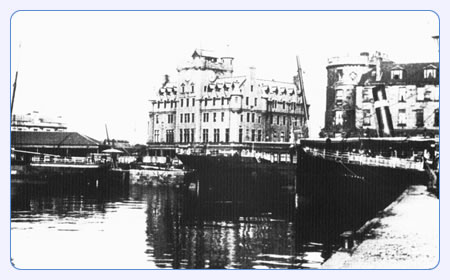

 |
 |
|||||||
The Changing Face of Leith The decades after the Second World War saw a rapid decline in the fortunes of Leith both as a port and as a centre of ship building excellence as purveyed by Ramage & Ferguson and Henry Robb. Robb’s yard had played a serious part in the repair and construction of both small naval vessels and merchantmen during the war and continued on for another quarter century, but the serious work went firstly to the Clyde and then later abroad. |
|
 |
|
The port continued to handle its share of import and export goods and has done so to this day. However improving methods of handling and the use of container systems elsewhere led to drastic reductions in the manpower needed. With low housing standards and high unemployment, Leith in the 1960’s and 70’s reached a low point in its self-esteem. Business and warehouses were steadily relocating to more convenient industrial estates and the older and more run down tenements were subject to health closing orders and subsequent piecemeal demolition. Fine old warehouses and workshops stood empty while the city authorities continued to build the necessary but singular unattractive housing that now stigmatises the period. The very centre of Leith around the old docks built along the banks of the Water of Leith suffered most. The quaysides were too small and inconvenient for any kind of shipping use, the lifting road bridges had long been replaced by permanent structures and finally the Victoria swing bridge was ‘mothballed’ by the port authority. On the positive side the construction of the sea lock entrance to the docks kept the entire dock, the largest enclosed seawater area in Europe, at high tide level. This considerably improved the aspect of the old docks, which were therefore now longer tidal, removing from view the low tide mud banks. However many buildings in the area continued to deteriorate by being either vacant or put to uses at rents that could not maintain them. Fortunately there were enough individuals with enthusiasm and vision to see the potential that existed in finding new uses for these buildings even at that dark hour. One of the first buildings to receive attention was the Cooperage on Commercial Quay which was adapted for residential use in the early 1980’s by a small development company, Water of Leith Ltd. Whereas the actual conversion of the building from a cooperage and warehouse on 5 floors to flats presented few problems, the financing of the project proved difficult – banks were, at the time, unwilling to risk funding any construction in Leith. With ‘perseverance’ however the project was financed and completed and followed by others in ever increasing numbers. In the centre of all this redevelopment activity there lies, relatively unexploited, the original dock and quayside area bounded to the north by the Victoria swing bridge together with the new concrete bridge which carries the new road linking Ocean Terminal to the north end of Constitution Street. The construction of this new road bridge has effectively sealed off the old docks from the newer Victorian limiting any use of the old docks severely. It is with this restraint and the consideration of Leith’s maritime history and its very rich and varied architectural heritage in mind that Water of Leith 2000 Ltd, the present owners of the solum of river and quaysides, have undertaken the development of the old dock area. Many cities in Britain and Europe have incorporated their unused dock and quayside areas into their townscapes with varied success. The particular problem for Leith lies, as explained, in the restriction that any vessels brought into the area must either pass under the bridges to the north (clearance less than 1 metre) or be delivered by road transport and then deposited in the water by crane. These restrictions mean, of course, that there will be no ‘visiting’ ships or boats. For example when the tall ships visited Leith the smaller vessels which could have in the past, moored alongside The Shore and Custom House Quay were unable to do so - a great pity. What a sight it would/could/should have been - fully rigged ships alongside right up to Bernard Street Bridge. Water of Leith 2000 Ltd is taking its responsibilities seriously whilst making clear at the same time that it is a commercial organisation seeking to make profits. The pace of development is slow but steady, giving due consideration to the highs and lows of other water based business developments and in consultation with our own planning authority and others. |
| © 2006 Water of Leith 2000 Ltd |